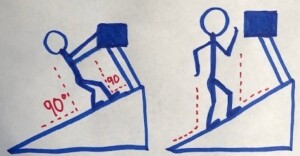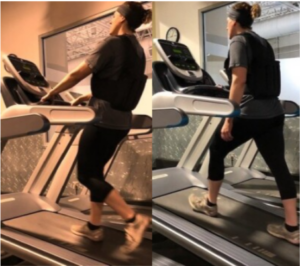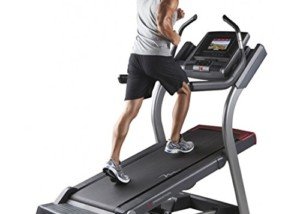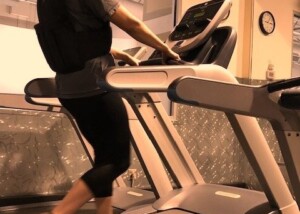
Find out what’s going on when after spending lots of time on a treadmill incline, you get pooped very quickly hiking up hills.
So, you’ve been faithfully using a treadmill incline, spending even an hour at a time, only to find yourself fatiguing very rapidly as you walk up a hiking trail.
When Incline Work on a Treadmill Fails to Prepare You for Hiking Hills
If you’ve been holding onto the treadmill while using the incline, this is precisely why you start heaving for air within minutes of walking up a hill outdoors!
Amazingly, few people make this connection.
Why does holding onto a treadmill interfere with training for a hike?
The answer is simple: When you walk up a hill outside, you’re not holding onto anything. Your entire core, buttocks and legs are forced to do all the work.
Let’s break this down. When you walk an incline without holding onto anything (be it a treadmill or a hiking trail), your body is vertical.
The angle between your body and the trail before you is acute, meaning, less than 90 degrees (or less than perpendicular).
When you walk on a flat course, this angle is 90 degrees (perpendicular). Lower body joint flexion is less than what it is when walking up a hill, which is why flat walking is a lot easier than incline trails.
When you walk down a hill, the angle between your vertical body and the ground ahead is obtuse: greater than 90 degrees.
Lower body joint flexion is further decreased, which is why walking downhill is very easy on the butt, leg and low back muscles.
When you hold onto the front bar or behind the console of a treadmill while using an incline, this puts your body into a perpendicular angle with the tread.
This mimics a flat walk, because your body gets tilted back at the same angle as the incline! Your body is not at an acute angle as it would be outside on a hill.

Holding on mimics a flat walk, because your body gets tilted back at the same angle as the incline! Your body is not at an acute angle as it would be outside on a hill.
Furthermore, your arms (especially if locked-out straight) absorb a significant amount of workload, making the “walking” easy on your lower body!
There is no way this will carry over to actual outdoor hill hiking. Absolutely not. Never.
Even if you’ve spent every single day using a treadmill’s highest incline for hour-long 3.5 mph sessions, if you’ve been doing this with your hands on the treadmill — you will become breathless within several minutes of walking 3.5 mph up the same slope grade outside.
And even if you hike at a slower pace, you’ll still find it difficult — unless you move like a snail.
When holding onto a treadmill, your body gets no training at walking at an acute angle.
The butt, back and leg muscles get zero training at handling a slope. Don’t be surprised when on a hike, your muscles are soon aching and you’re breathing very hard.
Now if you grip the side of the treadmill while using an incline, this will suppress the exaggerated tilting back of the body, but it still will not prepare you for hiking because your arms become anchors, subtracting significant workload from the butt, low back and legs.
The only way to train for hiking is to use the treadmill incline without holding on.

Can the difference be any more clear? Holding on does NOT mimic hiking — unless there’s a motorized shopping cart slowly moving in front of you as you’re ascending a trail — and you’re clinging onto that cart for support!
Nobody will be towing you on a hike; so self-towing by holding onto a treadmill will fail big-time at conditioning your body for climbing hills outdoors.
Using the incline without holding onto the treadmill provides an impressive carryover to outdoor hiking on similarly-angled slopes.
If a hike up a 15 percent trail (give or take minor fluctuations in grade) forces you to walk around 1.8 mph, then you can train for this by setting the treadmill to 15 percent, the speed at 2 mph, and keeping your hands off the machine.
Few hikers can sustain a 3.5, let alone 4 mph walking pace up a 15 percent grade.
When hikers DO go this speed, it’s nearly always in the form of a jog.
 Lorra Garrick is a former personal trainer certified through the American Council on Exercise. At Bally Total Fitness she trained women and men of all ages for fat loss, muscle building, fitness and improved health.
Lorra Garrick is a former personal trainer certified through the American Council on Exercise. At Bally Total Fitness she trained women and men of all ages for fat loss, muscle building, fitness and improved health.
.









































